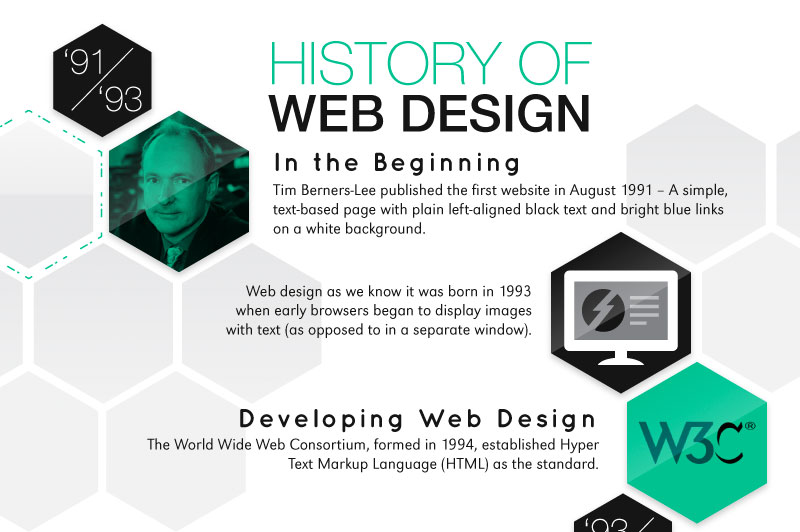Get Ready To Journey Via Time And Discover Just How Sites Have Actually Come To Be A Lot More Advanced, User-Friendly, And Aesthetically Magnificent
Get Ready To Journey Via Time And Discover Just How Sites Have Actually Come To Be A Lot More Advanced, User-Friendly, And Aesthetically Magnificent
Blog Article
Content Produce By-Bradshaw Peters
In the past, internet sites were straightforward and focused on information. Navigation was straight, and design was for desktops. Now, customer experience is vital. Data guides layouts for very easy navigation. Responsive designs suit various devices. https://www.medicaleconomics.com/view/5-ways-to-improve-your-practice-s-digital-marketing-efforts-in-2022 , dark mode decreases strain, and minimalist food selections improve navigation. Interactive functions engage users, and vibrant visuals stick out. AI assimilation boosts interaction. See how style has actually developed to enhance your on the internet trip.
Very Early Days of Web Design
In the very early days of web design, simplicity reigned supreme. Internet sites were standard, with minimal shades, font styles, and designs. The focus was on giving info rather than showy visuals. Users accessed the internet through slow-moving dial-up links, so rate and performance were vital.
Navigating menus were straightforward, generally located at the top or side of the web page. Web sites were designed for desktop computers, as mobile surfing wasn't yet widespread. Material was king, and designers focused on very easy readability over complicated layout elements.
HTML was the main coding language used, and designers had to function within its restrictions. Computer animations and interactive functions were minimal compared to today's criteria. Internet sites were fixed, with little dynamic web content or tailored user experiences.
Rise of User-Focused Layout
With the advancement of internet site style, a change towards user-focused style principles has ended up being significantly famous. Today, producing sites that prioritize individual experience is critical for involving visitors and attaining business objectives. User-focused layout includes recognizing the demands, preferences, and habits of your target audience to tailor the web site's layout, content, and features appropriately.
Designers currently conduct extensive research study, such as user studies and use testing, to gather understandings and feedback straight from individuals. This data-driven method assists in producing user-friendly navigation, clear calls-to-action, and aesthetically enticing interfaces that reverberate with site visitors. By placing the user at the center of the design process, web sites can provide a more individualized and enjoyable experience.
Receptive style has actually additionally emerged as a vital aspect of user-focused layout, making sure that sites are enhanced for numerous tools and screen dimensions. This flexibility boosts availability and functionality, accommodating the diverse ways individuals engage with internet sites today. Basically, the increase of user-focused layout signifies a shift in the direction of producing electronic experiences that focus on the needs and assumptions of the end customer.
Modern Trends in Website Design
Check out the latest patterns forming web design today. One prominent trend is dark setting style, using a smooth and modern appearance while lowering eye pressure in low-light atmospheres. An additional crucial pattern is minimal navigation, streamlining food selections and enhancing individual experience by focusing on essential elements. Including micro-interactions, such as animated buttons or scrolling impacts, can create a more engaging and interactive web site. Responsive design stays crucial, making certain smooth user experiences across numerous gadgets. Additionally, utilizing strong typography and asymmetrical layouts can add visual passion and accentuate particular web content.
Incorporating AI technology, like chatbots for client assistance or tailored referrals, improves user involvement and enhances procedures. Access has likewise become a substantial pattern, with developers prioritizing comprehensive layout methods to deal with varied customer needs. Accepting sustainability by maximizing web site efficiency for rate and performance is an additional emerging pattern in website design. Collaborating with customer responses and data analytics to repeat and improve design constantly is crucial for remaining appropriate in the ever-evolving electronic landscape. By accepting these modern-day trends, you can produce a visually attractive, straightforward web site that resonates with your target market.
Final thought
As you reflect on the advancement of web site design from the early days to now, you can see exactly how user-focused style has actually ended up being the driving pressure behind modern-day trends.
Welcome the trip of modification and adaptation in website design, constantly maintaining the customer experience at the forefront.
Remain existing with the most up to date fads and innovations, and never quit evolving your approach to produce visually stunning and easy to use sites.
Progress, adapt, and produce - the future of web design remains in your hands.
